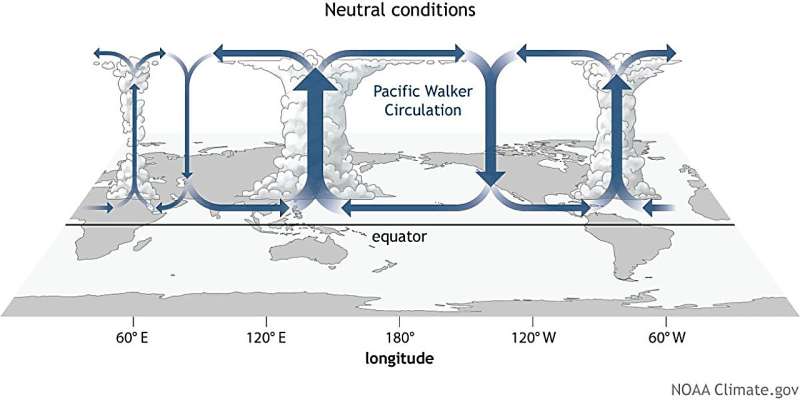This article has been reviewed according to Science X's editorial process and policies. Editors have highlighted the following attributes while ensuring the content's credibility:
fact-checked
peer-reviewed publication
trusted source
proofread
El Niño and La Niña multi-year events could become more common

The Pacific Ocean covers 32% of Earth's surface area, more than all the land combined. Unsurprisingly, its activity affects conditions around the globe.
Periodic variations in the ocean's water temperature and winds, called the El Niño–Southern Oscillation, are a major meteorologic force. Scientists know that human activity is affecting this system, but are still determining the extent.
A new study in Nature has revealed that the atmospheric component—called the "Pacific Walker Circulation"—has changed its behavior over the industrial era in ways that weren't expected. The international team of authors also found that volcanic eruptions can cause the Walker Circulation to temporarily weaken, inducing El Niño conditions. The results provide important insights into how El Niño and La Niña events may change in the future.
"The question is, 'How does the background circulation change?'" said co-author Samantha Stevenson, an associate professor at UC Santa Barbara's Bren School of Environmental Science & Management. "We care about the Walker Circulation because it affects weather around the world."
Earth's rotation causes warm surface water to pool on the western side of ocean basins. In the Pacific, this induces more humid conditions in Asia, with low-altitude trade winds blowing west across the sea. The high-altitude easterlies create an atmospheric circulation—the Walker Circulation—that drives weather patterns in the tropical Pacific, and far beyond.
"The tropical Pacific has an outsized influence on global climate," said Sloan Coats, study co-author and assistant professor of Earth sciences in the University of Hawai'i at Mānoa School of Ocean and Earth Science and Technology. "Understanding how it responds to volcanic eruptions, anthropogenic aerosols and greenhouse gas emissions is fundamental to confidently predicting climate variability."
These effects leave biologic and geologic signatures. The team used data from ice cores, trees, lakes, corals and caves to investigate the long-term weather patterns of the Pacific over the past 800 years.
"They aren't thermometers, but they contain information about the climate," Stevenson said.
Certain conditions favor uptake of heavier or lighter versions of an element, called an isotope, into structures like carbonate skeletons, sediment and tree rings. The researchers used sophisticated statistics to analyze the ratios of different types of oxygen and hydrogen. This allowed them to track how the Walker Circulation changed in the past and compare trends from before and after the rise in greenhouse gases.
"We set out to determine whether greenhouse gases had affected the Pacific Walker Circulation," said lead author Georgy Falster, a research fellow at the Australian National University and the ARC Center of Excellence for Climate Extremes. "We found that the overall strength hasn't changed yet, but instead, the year-to-year behavior is different." Falster started this research as a postdoctoral research associate at Washington University in St. Louis.
They observed that the length of time for the Walker Circulation to switch between El Niño-like and La Niña-like phases has slowed slightly over the industrial era. "That means in the future we could see more of these multi-year La Niña or El Niño events as the atmospheric flow above the Pacific Ocean switches more slowly between the two phases," Falster said. That could exacerbate the associated risks of drought, fire, rains and floods.
That said, the authors didn't notice any significant change in the circulation's strength—yet. "That was one surprising result," Stevenson said, "Because by the end of the 21st century, most climate models suggest that the Walker Circulation will weaken."
They also found that volcanic eruptions impacted the circulation. "Following a volcanic eruption, we see a very consistent weakening of the Pacific Walker Circulation," said co-author Bronwen Konecky, an assistant professor at Washington University in St. Louis. This causes El Niño-like conditions following eruptions.
"Our study provides long-term context for a fundamental component of the atmosphere-ocean system in the tropics," said Coats, whose expertise covers climate variability over the last 2,000 years. "Understanding how the Pacific Walker Circulation is affected by climate change will enable communities across the Pacific and beyond to better prepare for the challenges they may face in the coming decades."
Understanding the effect of climate change on the Walker Circulation is also important for creating reliable predictions. "If we don't know what happened in the real world, then we don't know if the models that we're using to project future changes, […] impacts and risks are giving us the right picture," Stevenson explained.
The researchers are currently looking into what might be causing the changes they witnessed in the Walker Circulation. One of Stevenson's doctoral students is working on a model of the system that includes the ratios of hydrogen and oxygen isotopes. Developing a model that predicts these measurements will provide the researchers with a tool to test different hypotheses.
Marcie Grabowski at University of Hawai'i at Mānoa contributed to this work.
More information: Georgina Falster, Forced changes in the Pacific Walker Circulation over the past millennium, Nature (2023). DOI: 10.1038/s41586-023-06447-0. www.nature.com/articles/s41586-023-06447-0
Journal information: Nature
Provided by University of California - Santa Barbara




















